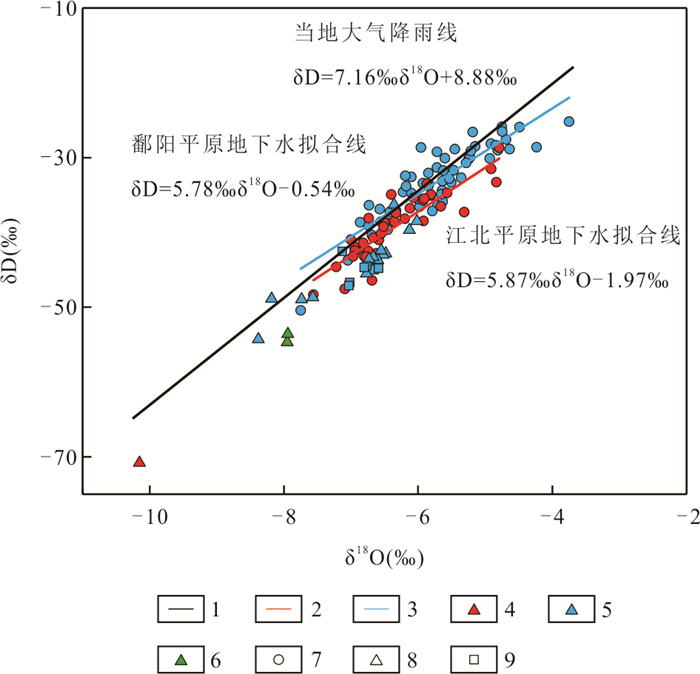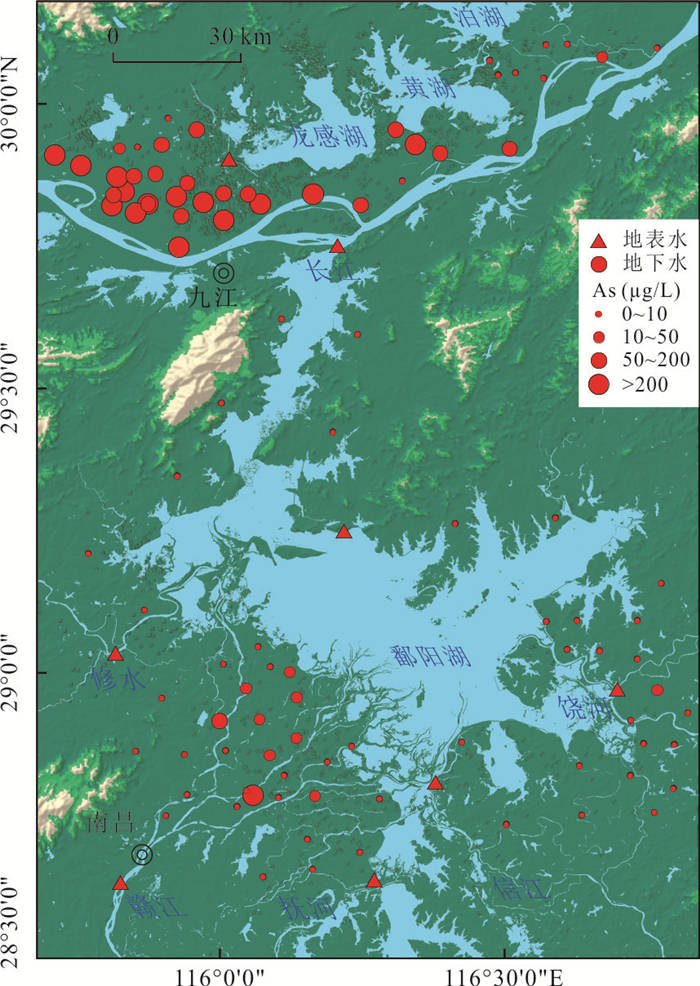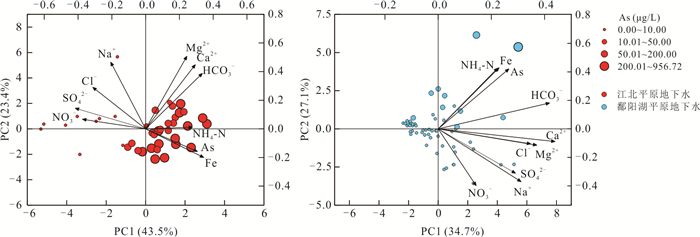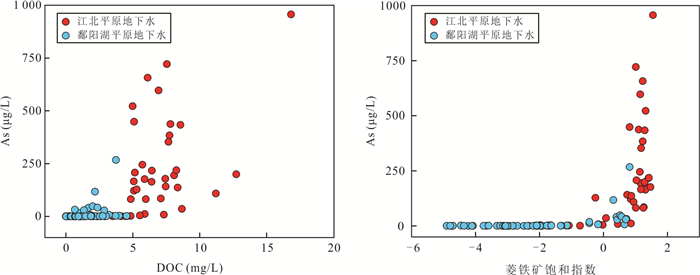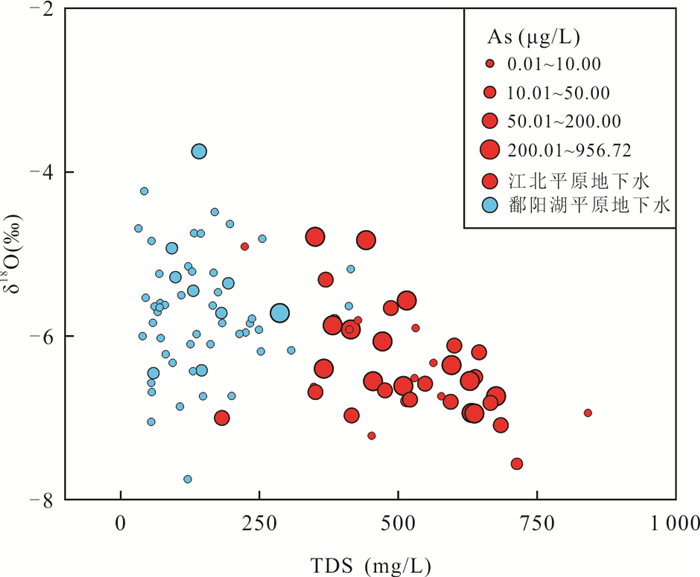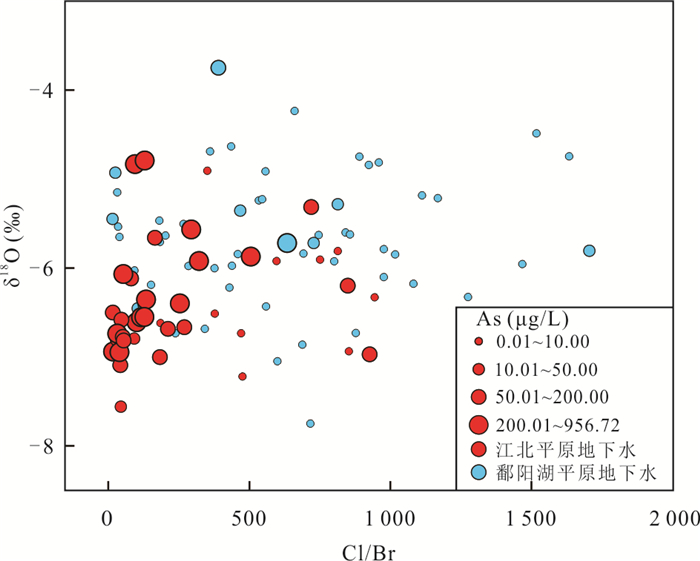Isotopic Indication of Spatial Heterogeneity of Arsenic in Shallow Groundwater of Middle Yangtze River Lacustrine Plain
-
摘要: 近年来陆续有报道发现长江中游河湖平原广泛分布着高砷地下水,鄱阳湖平原与江北平原(古彭蠡泽)作为长江中游南北两岸典型的河湖平原,其地下水资源丰富,但砷的空间分布规律尚不清楚,区域供水安全存在风险.本研究在两个区域系统采集98个浅层地下水(< 40 m)样品和8个地表水样品,通过水化学、氢氧稳定同位素分析,查明地下水中砷的空间分布异质性及其影响因素.研究发现江北平原浅层地下水砷含量为0.65~956.72 μg/L(平均值210.78 μg/L),高砷地下水集中分布于长江古河道;鄱阳湖平原浅层地下水砷含量为0.09~267.45 μg/L(平均值11.85 μg/L),高砷地下水仅分布于赣江三角洲局部地区.江北平原地下水δD与δ18O值相对鄱阳湖平原更偏负,且与地表水的差异更大.地下水化学及主成分分析结果表明物源和含水层结构差异是影响鄱阳湖平原和江北平原砷空间分布异质性的关键因素,来自长江物源的古彭蠡泽区域沉积物为高砷含水层的形成提供了物质来源,湖相含水层中含砷铁氧化物的还原性溶解是地下水砷富集的主要过程.地下水氢氧稳定同位素指示江北平原较鄱阳湖平原地下水赋存环境更封闭,地下水循环交替速度缓慢,有利于砷的富集.Abstract: In recent years, it has been reported that high arsenic groundwater is widely distributed in the the middle Yangtze River lacustrine plain. The Poyang Lake plain (PYP) and the Jiangbei plain (ancient Pengli Lake, JBP) are typical lacustrine plains rich in groundwater resources on the northern and southern sides of the middle reach of the Yangtze River. However, the spatial distribution of groundwater arsenic in these regions has not been clearly studied, which posed potential risks to regional water supply security. In this study, 98 shallow groundwater samples and 8 surface water samples were collected in these two regions. The spatial heterogeneity of arsenic in groundwater and its controlling factors were identified by hydrochemistry and stable isotope analysis. The arsenic contents of shallow groundwater in JBP range from 0.65 to 956.72 μg/L (average 210.78 μg/L), and the high arsenic groundwater is mainly distributed in the ancient Yangtze River channel. The arsenic contents of shallow groundwater in PYP range from 0.09 to 267.45 μg/L (average 11.85 μg/L), and the high arsenic groundwater is only distributed in parts of Ganjiang River delta. Stable water isotope composition (δD and δ18O) of groundwater samples from the JBP is more negative and significantly different from surface water relative to the PYP. Multivariate statistical results of groundwater chemistry data indicate that the differences of provenance and aquifer structure are the key factors affecting arsenic spatial heterogeneity in shallow groundwater in PYP and JBP, the microbially mediated reductive dissolution of arsenic-bearing iron minerals leads to arsenic release in groundwater. Groundwater arsenic in the Jiangbei plain is supposed to be originated from the sediments from ancient Pengli area of Yangtze River provenance. The stable isotopic signatures of hydrogen and oxygen in groundwater indicate that the aquifer environment in JBP is closer and the groundwater circulation and alternation speed is slower compared with the PYP, which is more conducive to arsenic release and enrichment in the groundwater.
-
Key words:
- groundwater /
- arsenic /
- hydrogen and oxygen stable isotopes /
- Poyang Lake plain /
- ancient Pengli Lake /
- geochemistry
-
表 1 鄱阳湖平原及江北平原地下水水化学特征
Table 1. Water chemistry of groundwater from Poyang Lake plain and Jiangbei plain
指标 鄱阳湖平原 江北平原 最小值 最大值 平均值 标准差 标准差 变异系数 最小值 最大值 平均值 标准差 变异系数 pH 4.70 7.42 6.06 0.61 0.61 0.10 6.66 7.26 6.97 0.14 0.02 EC (μS/cm) 55.50 612.00 246.69 135.68 135.68 0.55 292.00 1 148.00 751.45 180.35 0.24 Eh (mV) -137.00 322.50 152.39 121.91 121.91 0.80 -174.80 181.20 -50.31 114.71 -2.28 Fe2+(mg/L) ND 27.00 2.89 6.59 6.59 2.28 ND 14.75 5.03 4.02 0.80 NH4-N(mg/L) ND 23.00 1.09 3.29 3.29 3.02 0.01 15.60 3.37 3.13 0.93 DOC(mg/L) ND 4.54 1.53 1.07 1.07 0.70 1.98 16.83 6.57 2.69 0.41 Ca (mg/L) 2.19 105.79 23.80 19.75 19.75 0.83 38.49 209.91 137.91 40.00 0.29 Na (mg/L) 3.08 47.67 13.45 9.68 9.68 0.72 7.28 84.09 19.81 13.27 0.67 Mg (mg/L) 0.95 19.50 6.13 3.98 3.98 0.65 14.24 50.50 32.91 9.21 0.28 Cl- (mg/L) 0.52 147.37 20.28 23.52 23.52 1.16 0.92 72.74 12.59 15.86 1.26 NO3- (mg/L) 0.01 111.71 19.92 27.09 27.09 1.36 0.01 94.64 9.84 21.94 2.23 SO42- (mg/L) 0.01 47.71 10.96 13.70 13.70 1.25 0.01 79.34 11.49 21.72 1.89 HCO3- (mg/L) 9.19 290.91 95.57 69.77 69.77 0.73 17.24 862.01 565.30 203.51 0.36 As (µg/L) 0.09 267.45 11.85 38.63 38.63 3.26 0.65 956.72 210.78 227.64 1.08 Fe (mg/L) 0.01 48.08 5.82 12.98 12.98 2.23 0.01 20.30 6.63 5.57 0.84 Mn (mg/L) 0.01 21.21 1.34 3.08 3.08 2.30 0.01 3.48 0.47 0.61 1.30 注:ND.表示低于检出限. 表 2 鄱阳湖平原及江北平原地下水因子贡献率
Table 2. Contribution ratios of groundwater factors from PYP and JBP
指标 江北平原 鄱阳湖平原 主因子方差 PC1 PC2 PC3 主因子方差 PC1 PC2 PC3 Ca 0.890 0.613 0.687 -0.204 0.827 0.817 -0.147 -0.372 Mg 0.871 0.508 0.776 0.100 0.613 0.690 -0.188 -0.318 Na 0.770 -0.431 0.712 0.277 0.816 0.580 -0.609 0.331 HCO3- 0.772 -0.651 0.444 0.388 0.841 0.647 -0.174 0.626 Cl- 0.917 0.700 0.593 -0.277 0.886 0.779 0.299 -0.436 SO42- 0.628 -0.780 0.102 0.097 0.828 0.266 -0.655 0.573 NO3- 0.821 -0.869 0.220 0.130 0.700 0.541 -0.512 -0.382 As 0.578 0.639 -0.243 0.333 0.766 0.494 0.692 0.207 Fe 0.741 0.717 -0.305 0.365 0.774 0.426 0.705 0.310 NH4-N 0.709 0.576 0.018 0.613 0.707 0.416 0.701 0.206 贡献率(%) 43.529 23.414 10.021 34.692 27.060 15.846 累计贡献率(%) 43.529 66.943 76.964 34.692 61.752 77.598 -
Brammer, H., Ravenscroft, P., 2009. Arsenic in Groundwater: A Threat to Sustainable Agriculture in South and South-East Asia. Environment International, 35(3): 647-654. https://doi.org/10.1016/j.envint.2008.10.004 Cao, H.L., 2019. The Effect of Hydrodynamic Conditions on Sulfidization of Arsenic-Bearing Ferrihydrite and the Fate of Arsenic (Dissertation). China University of Geosciences, Wuhan (in Chinese with English abstract). Coles, C.A., Rohail, D., 2020. Effect of Aeration, Iron and Arsenic Concentrations, and Groundwater Matrix on Arsenic Removal Using Laboratory Sand Filtration. Environmental Geochemistry and Health, 42(11): 4051-4064. https://doi.org/10.1007/s10653-020-00671-7 Deng, T.L., Wu, Y., Yu, X.P., et al., 2014. Seasonal Variations of Arsenic at the Sediment-Water Interface of Poyang Lake, China. Applied Geochemistry, 47: 170-176. https://doi.org/10.1016/j.apgeochem.2014.06.002 Deng, Y.M., Wang, Y.X., Li, H.J., et al., 2015. Seasonal Variation of Arsenic Speciation in Shallow Groundwater from Endemic Arsenicosis Area in Jianghan Plain. Earth Science, 40(11): 1876-1886(in Chinese with English abstract). Deng, Y.M., Zheng, T.L., Wang, Y.X., et al., 2018. Effect of Microbially Mediated Iron Mineral Transformation on Temporal Variation of Arsenic in the Pleistocene Aquifers of the Central Yangtze River Basin. Science of the Total Environment, 619-620: 1247-1258. https://doi.org/10.1016/j.scitotenv.2017.11.166 Dong, Y.H., Li, J.L., Sun, Z.X., et al., 2019. Bacterial Diversity and Community Structure in Nitrate-Contaminated Shallow Groundwater in the Poyang Lake Basin, China. E3S Web of Conferences, 98: 01012. https://doi.org/10.1051/e3sconf/20199801012 Du, H.Y., Wang, H.X., Chi, Z.L., et al., 2021. Burst of Hydroxyl Radicals in Sediments Derived by Flooding/Drought Transformation Process in Lake Poyang, China. Science of the Total Environment, 772: 145059. https://doi.org/10.1016/j.scitotenv.2021.145059 Emerman, S.H., Prasai, T., Anderson, R.B., et al., 2010. Arsenic Contamination of Groundwater in the Kathmandu Valley, Nepal, as a Consequence of Rapid Erosion. Journal of Nepal Geological Society, 40: 49-60. https://doi.org/10.3126/jngs.v40i0.23595 Feng, W.J., Mariotte, P., Xu, L.G., et al., 2020. Seasonal Variability of Groundwater Level Effects on the Growth of Carex Cinerascens in Lake Wetlands. Ecology and Evolution, 10(1): 517-526. https://doi.org/10.1002/ece3.5926 Guo, H.M., Ni, P., Jia, Y.F., et al., 2014. Types, Chemical Characteristics and Genesis of Geogenic High-Arsenic Groundwater in the World. Earth Science Frontiers, 21(4): 1-12(in Chinese with English abstract). Hu, C.L., Zhang, Y.F., Jiang, Z.X., et al., 2021. Development of Large-Scale Sand Bodies in a Fault-Bounded Lake Basin: Pleistocene-Holocene Poyang Lake, Southern China. Journal of Paleolimnology, 65(4): 407-428. https://doi.org/10.1007/s10933-021-00179-9 Huang, S.B., Han, Z.T., Zhao, L., et al., 2015. Hydrochemistry Indicating Groundwater Contamination and the Potential Fate of Chlorohydrocarbons in Combined Polluted Groundwater: A Case Study at a Contamination Site in North China. Bulletin of Environmental Contamination and Toxicology, 94(5): 589-597. https://doi.org/10.1007/s00128-015-1513-9 Li, Q., 2012. Poyang Lake and Economy of Jiangxi in History (Dissertation). Jiangxi Normal University, Nanchang(in Chinese with English abstract). Li, Y., Bi, Y.H., Mi, W.J., et al., 2021. Land-Use Change Caused by Anthropogenic Activities Increase Fluoride and Arsenic Pollution in Groundwater and Human Health Risk. Journal of Hazardous Materials, 406: 124337. https://doi.org/10.1016/j.jhazmat.2020.124337 Liao, F., Wang, G.C., Shi, Z.M., et al., 2018. Distributions, Sources, and Species of Heavy Metals/Trace Elements in Shallow Groundwater around the Poyang Lake, East China. Exposure and Health, 10(4): 211-227. https://doi.org/10.1007/s12403-017-0256-8 Liu, W.Z., 1996. Penglize and Poyang Lake. Journal of Nanchang University (Social Science), 27 (2): 63-64(in Chinese). Long, X.T., Liu, F., Zhou, X., et al., 2021. Estimation of Spatial Distribution and Health Risk by Arsenic and Heavy Metals in Shallow Groundwater around Dongting Lake Plain Using GIS Mapping. Chemosphere, 269: 128698. https://doi.org/10.1016/j.chemosphere.2020.128698 Lu, Z.J., Deng, Y.M., Du, Y., et al., 2017. EEMs Characteristics of Dissolved Organic Matter and Their Implication in High Arsenic Groundwater of Jianghan Plain. Earth Science, 42(5): 771-782(in Chinese with English abstract). McArthur, J.M., Sikdar, P.K., Hoque, M.A., et al., 2012. Waste-Water Impacts on Groundwater: Cl/Br Ratios and Implications for Arsenic Pollution of Groundwater in the Bengal Basin and Red River Basin. Vietnam. Science of the Total Environment, 437: 390-402. https://doi.org/10.1016/j.scitotenv.2012.07.068. Podgorski, J.E., Eqani, S.A.M.A.S., Khanam, T., et al., 2017. Extensive Arsenic Contamination in High-pH Unconfined Aquifers in the Indus Valley. Science Advances, 3(8): e1700935. https://doi.org/10.1126/sciadv.1700935 Poulton, S.W., Canfield, D.E., 2005. Development of a Sequential Extraction Procedure for Iron: Implications for Iron Partitioning in Continentally Derived Particulates. Chemical Geology, 214(3/4): 209-221. https://doi.org/10.1016/j.chemgeo.2004.09.003 Saha, N., Rahman, S., 2020. Groundwater Hydrogeochemistry and Probabilistic Health Risk Assessment through Exposure to Arsenic-Contaminated Groundwater of Meghna Floodplain, Central-East Bangladesh. Ecotoxicology and Environmental Safety, 206: 111349. https://doi.org/10.1016/j.ecoenv.2020.111349 Shakya, A.K., Ghosh, P.K., 2021. Biological Attenuation of Arsenic and Nitrate in a Suspended Growth Denitrifying-Sulphidogenic Bioreactor and Stability Check of Arsenic-Laden Biosolids. Environmental Technology, 42(11): 1723-1733. https://doi.org/10.1080/09593330.2019.1680737 Smedley, P.L., Kinniburgh, D.G., 2002. A Review of the Source, Behaviour and Distribution of Arsenic in Natural Waters. Applied Geochemistry, 17(5): 517-568. https://doi.org/10.1016/s0883-2927(02)00018-5 Soldatova, E., Guseva, N., Sun, Z.X., et al., 2017. Sources and Behaviour of Nitrogen Compounds in the Shallow Groundwater of Agricultural Areas (Poyang Lake Basin, China). Journal of Contaminant Hydrology, 202: 59-69. https://doi.org/10.1016/j.jconhyd.2017.05.002 Su, C.L., Wang, Y.X., Xie, X.J., et al., 2015. An Isotope Hydrochemical Approach to Understand Fluoride Release into Groundwaters of the Datong Basin, Northern China. Environmental Science Processes & Impacts, 17(4): 791-801. https://doi.org/10.1039/c4em00584h Wang, J.W., Zhang, C.X., Pan, Z.Z., et al., 2016. Distribution Characteristics and Influencing Factors of Organophosphorus Pesticides in Jianghan Plain Groundwater. China Environmental Science, 36(10): 3089-3098(in Chinese). Wei, Y.H., Zhang, J.Y., Zhang, D.W., et al., 2014. Metal Concentrations in Various Fish Organs of Different Fish Species from Poyang Lake, China. Ecotoxicology and Environmental Safety, 104: 182-188. https://doi.org/10.1016/j.ecoenv.2014.03.001 Yang, L., 2016. Study on the Geochemical Characteristics of Shallow Groundwater in the Poyang Lake Basin (Dissertation). East China Institute of Technology, Fuzhou(in Chinese with English abstract). Zhan, L.C., Chen, J.S., Huang, D.W., et al., 2016. Stable Isotope Characteristics in the Poyang Lake Region at Jiujiang Section of the Yangtze River in Different Seasons. Journal of Hydraulic Engineering, 47(11): 1380-1388(in Chinese with English abstract). Zheng, L.L., Wang, X.L., Li, D.H., et al., 2021. Spatial Heterogeneity of Vegetation Extent and the Response to Water Level Fluctuations and Micro-Topography in Poyang Lake, China. Ecological Indicators, 124: 107420. https://doi.org/10.1016/j.ecolind.2021.107420 Zheng, T.L., Deng, Y.M., Lu, Z.J., et al., 2017. Geochemistry and Implications of Rare Earth Elements in Arsenic-Affected Shallow Aquifer from Jianghan Plain, Central China. Earth Science, 42(5): 693-706(in Chinese with English abstract). Zhu, G.F., Li, Z.Z., Su, Y.H., et al., 2007. Hydrogeochemical and Isotope Evidence of Groundwater Evolution and Recharge in Minqin Basin, Northwest China. Journal of Hydrology, 333(2-4): 239-251. https://doi.org/10.1016/j.jhydrol.2006.08.013 曹海龙, 2019. 水动力条件对含砷水铁矿硫化反应的影响研究(硕士学位论文). 武汉: 中国地质大学. 邓娅敏, 王焰新, 李慧娟, 等, 2015. 江汉平原砷中毒病区地下水砷形态季节性变化特征. 地球科学, 40(11): 1876-1886. doi: 10.3799/dqkx.2015.168 郭华明, 倪萍, 贾永锋, 等, 2014. 原生高砷地下水的类型、化学特征及成因. 地学前缘, 21(4): 1-12. https://www.cnki.com.cn/Article/CJFDTOTAL-DXQY201404002.htm 李青, 2012. 历史上的鄱阳湖与江西经济(硕士学位论文). 南昌: 江西师范大学. 刘文政, 1996. 彭蠡泽与鄱阳湖考. 南昌大学学报(社会科学版), 27 (2): 63-64. https://www.cnki.com.cn/Article/CJFDTOTAL-NCDS602.011.htm 鲁宗杰, 邓娅敏, 杜尧, 等, 2017. 江汉平原高砷地下水中DOM三维荧光特征及其指示意义. 地球科学, 42(5): 771-782. doi: 10.3799/dqkx.2017.065 杨丽, 2016. 环鄱阳湖流域浅层地下水水文地球化学特征研究(硕士学位论文). 抚州: 东华理工大学. 詹泸成, 陈建生, 黄德文, 等, 2016. 长江干流九江段与鄱阳湖不同季节的同位素特征. 水利学报, 47(11): 1380-1388. https://www.cnki.com.cn/Article/CJFDTOTAL-SLXB201611005.htm 郑天亮, 邓娅敏, 鲁宗杰, 等, 2017. 江汉平原浅层含砷地下水稀土元素特征及其指示意义. 地球科学, 42(5): 693-706. doi: 10.3799/dqkx.2017.057 -









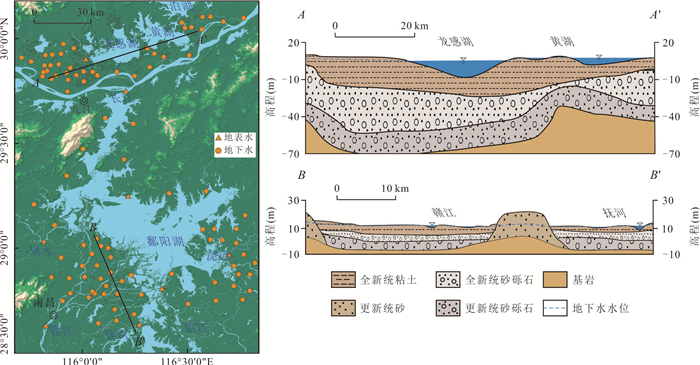
 下载:
下载:

